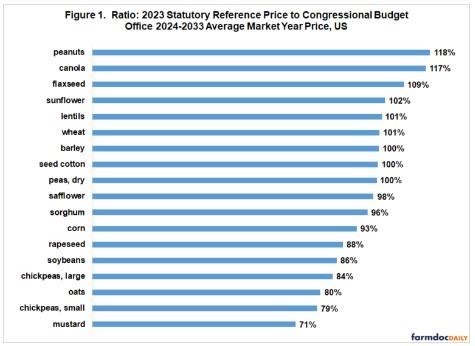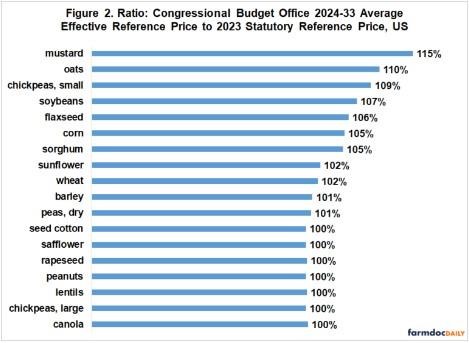By Carl Zulauf
Department of Agricultural, Environmental and Development Economics
Ohio State University
Gary Schnitkey and Nick Paulson
Department of Agricultural and Consumer Economics
University of Illinois
The farm bill debate has entered a world in which the Congressional Budget Office (CBO) baseline plays a key role (farmdoc daily, March 2, 2023). Unless Congress adds new money, the baseline will set farm bill spending limits. Farm bill actors are thus currently arguing for additional baseline money. Success or failure of this effort has important implications for the policy proposals that have a chance of being included in a new farm bill. If Congress does not add new baseline, proposals with the highest chance will require no new funds. Such a proposal is discussed as an illustration. It addresses the widely-varying relationship of statutory reference price to market price across program crops.
Statutory Reference Price Variation
The statutory reference price is important to farmers because it creates a floor on per unit support. Ratio of 2018 Farm Bill statutory reference price to average price that CBO projects for the 2024-2033 market years varies from 71% for mustard to 118% for peanuts (see Figure 1). The range is a 47 percentage points (118% – 71%). Notable variation also exists for crops often grouped together. Feed grains range from 100% (barley) to 80% (oats). Pulses range from 101% (lentils) to 79% (small chickpeas). Minor oilseeds range from 117% (canola) to 71% (mustard). Rice ranges from 117% (long grain rice) to 78% (temperate Japonica rice). In short, inequality exists. Note, rice is not in Figure 1. CBO projects only the all-rice US price. It is converted into price estimates for rice types by using average 2017-2021 market prices for each rice type.

CBO Projected Effective Reference Prices
CBO projects effective reference prices for the 2024-2033 market years. A program crop’s effective reference price is the higher of (a) its statutory reference price listed in the farm bill or (b) 85% of its Olympic average price for 5 recent market years, but (c) cannot exceed 115% of the statutory reference price. Effective reference price averages 115% to 100% of the 2023 statutory reference price (see Figure 2). A ratio of 100% means the statutory reference price is always the effective reference price. CBO thus projects the escalator option will not be used for seed cotton, safflower, rapeseed, peanuts, lentils, large chickpeas, and canola.
A ratio above 100% indicates that CBO projects the escalator will be used. The higher the ratio the greater the escalator’s impact on a crop’s projected payments. The escalator most impacts payments to corn and soybeans, plus mustard, oats, small chickpeas, and sorghum (see Figure 2). These crops also have a low statutory reference price relative to market price (see Figure 1). Combining these two observations suggests an option for reducing the inequality between statutory reference prices and market prices that requires no new funds. Specifically, eliminate the reference price escalator and use the budget savings for a program crop to increase that crop’s statutory reference price. Statutory reference prices are raised only for crops that currently have a low statutory reference price compared to its market price, thus reducing the variation across program crops. The proposal in essence asks the affected crops if they prefer payments via the escalator or via a higher statutory reference price.

Discussion
The farm bill debate has entered a world in which the CBO baseline plays a key role. Unless Congress adds new money, the baseline will set farm bill spending limits. Farm bill actors are currently trying to convince Congress to add new baseline. Whether or not new baseline is added will notably impact what policy proposals have the highest chance of being included in a new farm bill.
If no new baseline is added, proposals requiring no new money will have the highest chance. One objective of this article is to illustrate such a proposal. Eliminating the reference price escalator and using the budget savings for a program crop to increase that crop’s statutory reference price will reduce the inequality that exist between statutory reference and market prices. No new money is required. Each crop’s projected spending stays the same. It occurs either via the escalator or a higher statutory reference price. The impacted crops in essence choose which program design they prefer.
Reduction in inequality depends on savings CBO estimates by crop from removing the escalator. They depend on many factors, including price level and distribution, program participation, and base acres.
It is hard to understate the impact new baseline money will have on crafting the farm bill. The decision to add new baseline will likely be part of the debate over raising the Federal debt limit. The outcome will likely not be known until closer to the resolution of the Federal debt limit issue.
Source : illinois.edu